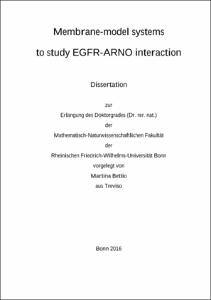Bettio, Martina: Membrane-model systems to study EGFR-ARNO interaction. - Bonn, 2017. - Dissertation, Rheinische Friedrich-Wilhelms-Universität Bonn.
Online-Ausgabe in bonndoc: https://nbn-resolving.org/urn:nbn:de:hbz:5n-45762
Online-Ausgabe in bonndoc: https://nbn-resolving.org/urn:nbn:de:hbz:5n-45762
@phdthesis{handle:20.500.11811/7092,
urn: https://nbn-resolving.org/urn:nbn:de:hbz:5n-45762,
author = {{Martina Bettio}},
title = {Membrane-model systems to study EGFR-ARNO interaction},
school = {Rheinische Friedrich-Wilhelms-Universität Bonn},
year = 2017,
month = jan,
note = {Transmembrane proteins are involved in important biological functions, such as in transport of molecules, and in signal transduction. They represent almost 25 % of the proteome and constitute important drug targets. The study of transmembrane proteins has been a major challenge for biochemical research over the past decades. Transmembrane proteins are unstable and prone to aggregation when examined apart from the plasma membrane. Artificial, yet native-like membrane systems have allowed for the identification of the structure and function of several transmembrane proteins. In this thesis, the analysis of different membrane-model systems to study a particular transmembrane protein, namely EGFR (epidermal growth factor receptor) is reported. Moreover, the interactions of EGFR with a cytosolic factor, i.e. ARNO (Arf nucleotide binding site opener), is analyzed. EGFR is involved in many cellular functions and alteration of its activity often leads to cancer development. ARNO acts as a GEF (guanine nucleotide exchange factor) for Arf (ADP ribosylation factor), due to its Sec7 domain. Furthermore, ARNO contains a PH (pleckstrin homology) domain, important for interactions with anionic lipids at the plasma membrane. By using nanodiscs, the conditions for the interaction between ARNO and anionic lipids in a membrane-like system were recreated. In addition, nanodiscs were used as a system to study a recently developed small-molecule inhibitor for the PH domain. Summarizing, nanodiscs were identified to be not only a suitable system to study protein-membrane interactions, but to be a viable in vitro system to study small-molecule compounds. Moreover, starting with receptor-micelles and proceeding to more complex artificial systems, such as bicelles, nanodiscs, and membrane sheets, ARNO-dependent EGFR phosphorylation and the interaction between the two proteins were evaluated. It has been previously reported that ARNO enhances EGFR phosphorylation in living cells, as well as the phosphorylation of the soluble intracellular domain of EGFR in membrane-free experiments. Depending on the membrane system, weak interactions between the Sec7 domain of ARNO and the JM (juxtamembrane) region of EGFR were observed. Nevertheless, ARNO-dependent EGFR activation was not observed in membrane-like systems. By using membrane sheets, the co-localization between ARNO and EGFR at the plasma membrane was detected. Furthermore, ARNO may have an effect on EGFR by decreasing receptor clustering and making EGFR more accessible for intracellular co-factors. These findings can open the way for a deeper understanding of the activation mechanisms of EGFR via ARNO.},
url = {https://hdl.handle.net/20.500.11811/7092}
}
urn: https://nbn-resolving.org/urn:nbn:de:hbz:5n-45762,
author = {{Martina Bettio}},
title = {Membrane-model systems to study EGFR-ARNO interaction},
school = {Rheinische Friedrich-Wilhelms-Universität Bonn},
year = 2017,
month = jan,
note = {Transmembrane proteins are involved in important biological functions, such as in transport of molecules, and in signal transduction. They represent almost 25 % of the proteome and constitute important drug targets. The study of transmembrane proteins has been a major challenge for biochemical research over the past decades. Transmembrane proteins are unstable and prone to aggregation when examined apart from the plasma membrane. Artificial, yet native-like membrane systems have allowed for the identification of the structure and function of several transmembrane proteins. In this thesis, the analysis of different membrane-model systems to study a particular transmembrane protein, namely EGFR (epidermal growth factor receptor) is reported. Moreover, the interactions of EGFR with a cytosolic factor, i.e. ARNO (Arf nucleotide binding site opener), is analyzed. EGFR is involved in many cellular functions and alteration of its activity often leads to cancer development. ARNO acts as a GEF (guanine nucleotide exchange factor) for Arf (ADP ribosylation factor), due to its Sec7 domain. Furthermore, ARNO contains a PH (pleckstrin homology) domain, important for interactions with anionic lipids at the plasma membrane. By using nanodiscs, the conditions for the interaction between ARNO and anionic lipids in a membrane-like system were recreated. In addition, nanodiscs were used as a system to study a recently developed small-molecule inhibitor for the PH domain. Summarizing, nanodiscs were identified to be not only a suitable system to study protein-membrane interactions, but to be a viable in vitro system to study small-molecule compounds. Moreover, starting with receptor-micelles and proceeding to more complex artificial systems, such as bicelles, nanodiscs, and membrane sheets, ARNO-dependent EGFR phosphorylation and the interaction between the two proteins were evaluated. It has been previously reported that ARNO enhances EGFR phosphorylation in living cells, as well as the phosphorylation of the soluble intracellular domain of EGFR in membrane-free experiments. Depending on the membrane system, weak interactions between the Sec7 domain of ARNO and the JM (juxtamembrane) region of EGFR were observed. Nevertheless, ARNO-dependent EGFR activation was not observed in membrane-like systems. By using membrane sheets, the co-localization between ARNO and EGFR at the plasma membrane was detected. Furthermore, ARNO may have an effect on EGFR by decreasing receptor clustering and making EGFR more accessible for intracellular co-factors. These findings can open the way for a deeper understanding of the activation mechanisms of EGFR via ARNO.},
url = {https://hdl.handle.net/20.500.11811/7092}
}






